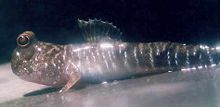- Mudskipper
-
Mudskippers 
Mudskippers in The Gambia Scientific classification Kingdom: Animalia Phylum: Chordata Superclass: Osteichthyes Class: Actinopterygii Superorder: Acanthopterygii Order: Perciformes Suborder: Gobioidei Family: Gobiidae Subfamily: Oxudercinae Genera Apocryptes
Apocryptodon
Boleophthalmus
Parapocryptes
Periophthalmodon
Periophthalmus
Pseudapocryptes
Scartelaos
ZappaMudskippers are members of the subfamily Oxudercinae (tribe Periophthalmini),[1] within the family Gobiidae (Gobies). They are completely amphibious fish, fish that can use their pectoral fins to walk on land.[2][3] Being amphibious, they are uniquely adapted to intertidal habitats, unlike most fish in such habitats which survive the retreat of the tide by hiding under wet seaweed or in tidal pools.[4] Mudskippers are quite active when out of water, feeding and interacting with one another, for example to defend their territories. They are found in tropical, subtropical and temperate regions, including the Indo-Pacific and the Atlantic coast of Africa.
Contents
Adaptations
Compared with fully aquatic gobies, these fish present a range of peculiar behavioural and physiological adaptations to an amphibious lifestyle. These include:
- Anatomical and behavioural adaptations that allow them to move effectively on land as well as in the water.[3] As their name implies, these fish use their fins to move around in a series of skips. They can also flip their muscular body to catapult themselves up to 2 feet (60 cm) into the air.[5]
- The ability to breathe through their skin and the lining of their mouth (the mucosa) and throat (the pharynx). This is only possible when the mudskipper is wet, limiting mudskippers to humid habitats and requiring that they keep themselves moist. This mode of breathing, similar to that employed by amphibians, is known as cutaneous air breathing.[4] Another important adaptation that aids breathing while out of water are their enlarged gill chambers, where they retain a bubble of air. These large gill chambers close tightly when the fish is above water, keeping the gills moist, and allowing them to function. They act like a scuba diver's cylinders, and supply oxygen for respiration also while on land.[4]
- Digging deep burrows in soft sediments allow the fish to thermoregulate,[6] avoid marine predators during the high tide when the fish and burrow are submerged,[7] and for laying their eggs.[8]
Even when their burrow is submerged, mudskippers maintain an air pocket inside it, which allows them to breathe in conditions of very low oxygen concentration.[9][10][11]
Species
The genus Periophthalmus is by far the most diverse and widespread genus of mudskipper. Eighteen species have been described.[12][13][14] Periophthalmus argentilineatus is one of the most widespread and well known species. It can be found in mangrove ecosystems and mudflats of East Africa and Madagascar east through the Sundarbans of Bengal, Southeast Asia to Northern Australia, southeast China and southern Japan, up to Samoa and Tonga Islands.[1] It grows to a length of about 9.5 cm [1] and is a carnivorous opportunist feeder. It feeds on small prey such as small crabs and other arthropods.[15] Another species, Periophthalmus barbarus, is the only oxudercine goby that inhabits the coastal areas of western Africa.[1]
References
- ^ a b c d Murdy EO (1989). "A Taxonomic Revision and Cladistic Analysis of the Oxudercine Gobies (Gobiidae: Oxudercinae)". Records of the Australian Museum Suppl 11: 1–93.
- ^ Swanson BO, Gibb AC (2004). "Kinematics of aquatic and terrestrial escape responses in mudskippers". The Journal of Experimental Biology 207 (Pt 23): 4037–44. doi:10.1242/jeb.01237. PMID 15498949. http://jan.ucc.nau.edu/~acg/Publications/Swanson_&_Gibb_2004.pdf.
- ^ a b Harris VA (1960). "On the locomotion of the mudskipper Periophthalmus koelreuteri (Pallas): Gobiidae". Proceedings of the Zoological Society of London 134: 107–35. doi:10.1111/j.1469-7998.1960.tb05921.x.
- ^ a b c Graham JB, ed (1997). Air–breathing Fishes. Evolution, Diversity and Adaptation. San Diego California: Academic Press.
- ^ Piper R (2007). Extraordinary Animals: An Encyclopedia of Curious and Unusual Animals. Greenwood Press.
- ^ Tytler P, Vaughan T (1983). "Thermal Ecology of the Mudskippers Periophthalmus koelreuteri (Pallas) and Boleophthalmus boddaerti (Pallas), of Kuwait Bay". Journal of Fish Biology 23 (3): 327–37. doi:10.1111/j.1095-8649.1983.tb02912.x.
- ^ Sasekumar A, Chong VC, Lim KH, Singh HR (1994). "The Fish Community of Matang Mangrove Waters, Malaysia". In Sudara S, Wilkinson CR, Chou LM. Proceedings, Third ASEAN-Australia Symposium on Living Coastal Resources. Research papers. 2. Bangkok: Chulalonghorn University. pp. 457–64.
- ^ Brillet C (1969). "Etude du comportement constructeur des poissons amphibies Periophthalmidae" (in French). Terre et la Vie 23 (4): 496–520.
- ^ Ishimatsu A, Hishida Y, Takita T, Kanda T, Oikawa S, Takeda T, Khoo KH (1998). "Mudskipper Store Air in Their Burrows". Nature 391 (6664): 237–8. doi:10.1038/34560.
- ^ Ishimatsu A, Takeda T, Kanda T, Oikawa S, Khoo KH (2000). "Burrow environment of mudskippers in Malaysia". Journal of Bioscience 11 (1–2): 17–28.
- ^ Lee HJ, Martinez CA, Hertzberg KJ, Hamilton AL, Graham JB (2005). "Burrow air phase maintenance and respiration by the mudskipper Scartelaos histophorus (Gobiidae: Oxudercinae)". The Journal of Experimental Biology 208 (Pt 1): 169–77. doi:10.1242/jeb.01361. PMID 15601887.
- ^ Larson HK, Takita T (2004). "Two new species of Periophthalmus (Teleostei: Gobiidae: Oxudercinae) from northern Australia, and a re-diagnosis of Periophthalmus novaeguineaensis". The Beagle, Records of the Museums and Art Galleries of the Northern Territory 20: 175–85.
- ^ Jaafar Z, Perrig M, Chou LM (2009). "Periophthalmus variabilis (Teleostei: Gobiidae: Oxudercinae), a valid species of mudskipper, and a re-diagnosis of Periophthalmus novemradiatus". Zoological Science 26 (4): 309–14. doi:10.2108/zsj.26.309. PMID 19798926.
- ^ Jaafar Z, Larson HL (2008). "A new species of mudskipper, Periophthalmus takita (Teleostei: Gobiidae: Oxudercinae), from Australia, with a key to the genus". Zoological Science 25 (9): 946–52. doi:10.2108/zsj.25.946. PMID 19267605.
- ^ Milward, NE (1974). Studies on the taxonomy, ecology and physiology of Queensland mudskippers (unpubl. Ph.D. dissertation ed.). Brisbane: University of Queensland.
See also
- Muddy the Mudskipper
External links
Categories:- Gobiidae
Wikimedia Foundation. 2010.

